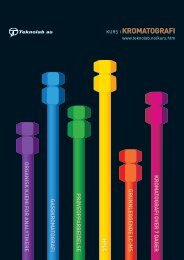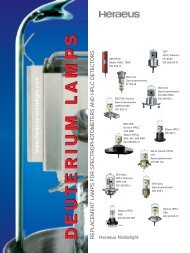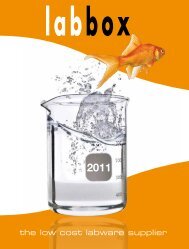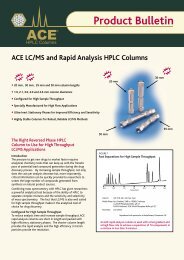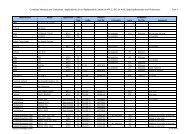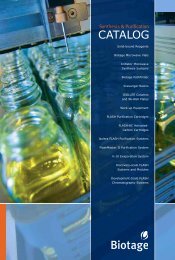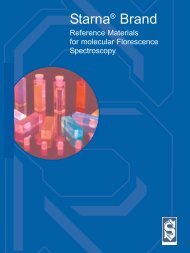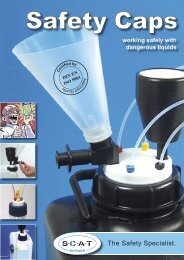PDF catalog - Teknolab AS
PDF catalog - Teknolab AS
PDF catalog - Teknolab AS
Create successful ePaper yourself
Turn your PDF publications into a flip-book with our unique Google optimized e-Paper software.
GUIDE QUICKSTART GUIDE TO SPE<br />
The retention of basic analytes by non-polar sorbents can often be enhanced using the secondary interaction<br />
with silanol (Si-O - ) groups present on the surface of the silica particle. To use this approach, the pH of the<br />
sample should be adjusted to ionize the silanol groups (Si-O - ) and protonate the analyte. A pH range between<br />
3 and 8 is normally evaluated.<br />
d) For ion exchange interactions, pH must be adjusted to ensure complete ionization of the analyte, and in the<br />
case of weak ion exchange sorbents (e.g. CBA, NH2 and PSA), the sorbent functional group.<br />
Analyte ionization conditions<br />
i) For basic analytes: adjust pH to 2 pH units below the pK of the analyte<br />
ii) For acidic analytes: adjust pH to 2 pH units above the pK of the analyte<br />
Sorbent ionization conditions<br />
(i) For ISOLUTE CBA, sample pH must be greater than 6.8<br />
(ii) For ISOLUTE NH2, sample pH must be less than 7.8 (or 8.1 for ISOLUTE PSA)<br />
It is important to ensure that the ionic strength of the sample is not so high as to weaken the ionic interactions.<br />
To overcome this, dilute with low ionic strength buffer. Failure to deal with high and variable ionic<br />
strength samples can result in low or variable recoveries when using ion exchange sorbents. For extraction of<br />
ionizable drugs from biological fluids, see Appendix 1b Mixed-mode SPE.<br />
e) For extraction of large volume aqueous samples (>25 mL) using non-polar silica based sorbents, it is<br />
necessary to add 0.5-5 % methanol or iso-propanol to the sample in order to maintain solvation of the sorbent<br />
bed during sample loading, and ensure high analyte recovery.<br />
Step 2:<br />
Column solvation<br />
In order for a proper phase interface to exist between the sorbent and the sample, most ISOLUTE SPE columns<br />
should be solvated prior to sample loading. Typical solvents are listed in Table 3. A typical volume<br />
of solvation solvent is 1 mL/100 mg sorbent.<br />
Step 3:<br />
Column equilibration<br />
Prior to sample loading, the SPE column should be ‘normalized’ to match the conditions of the pre-treated<br />
sample. This will ensure maximum analyte recovery.<br />
For example, if the sample is pH adjusted to suppress/ensure ionization of the analyte, equilibrate the column<br />
with a buffer of the same pH and ionic strength.<br />
For weak ion exchange sorbents, use buffer pH to also ensure ionization of sorbent for maximum capacity (see<br />
Table 3 for guidelines for specific sorbents).<br />
Step 4:<br />
Sample loading<br />
Extraction efficiency is flow rate dependant, so evaluation of the extraction efficiency vs. flow rate is a useful<br />
part of the method development process. See Table 4 (page 150) for suggested flow rates.<br />
Step 5:<br />
Interference elution<br />
Table 3 provides useful guidelines on the choice of interference elution solvents. N.B. for maximum analyte<br />
recovery, analyte retention conditions (e.g. pH and ionic strength) should be maintained during this step.<br />
147




